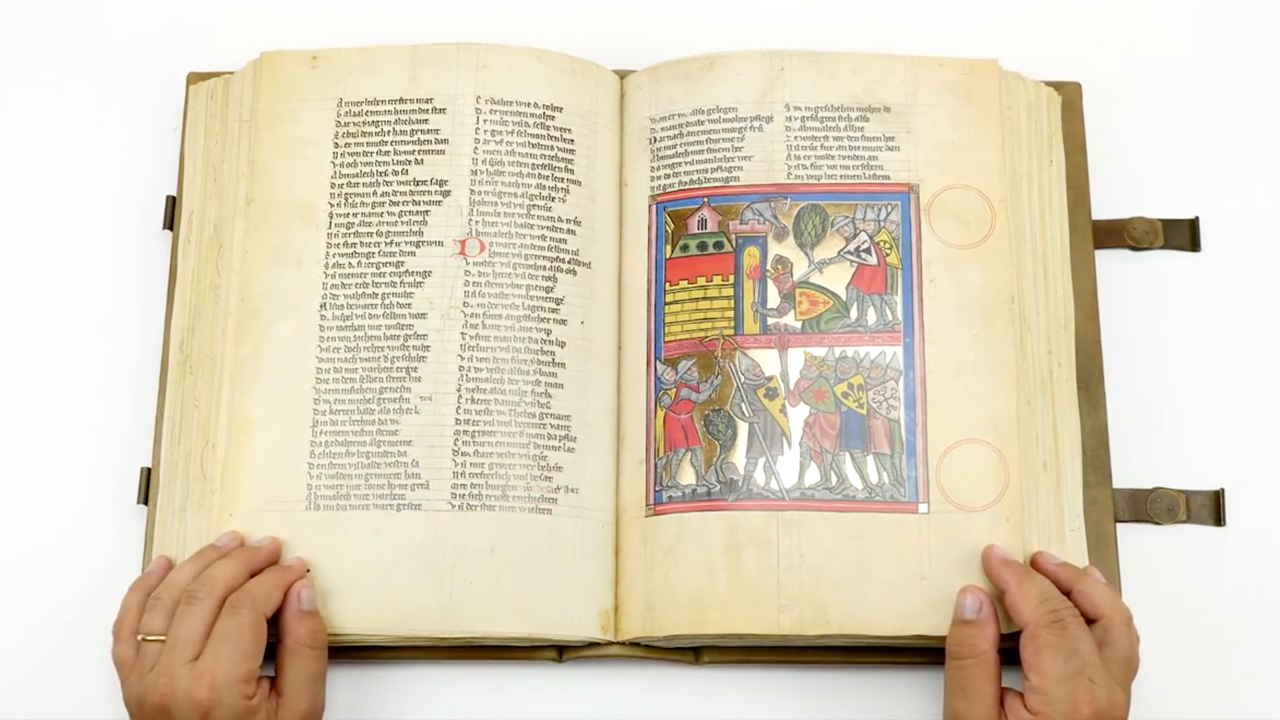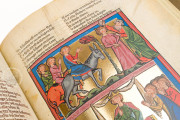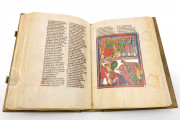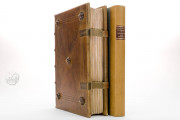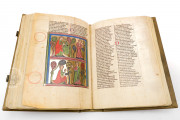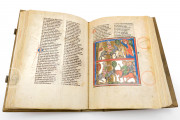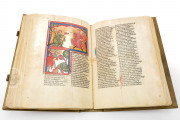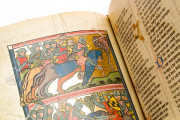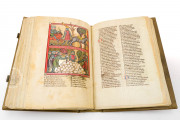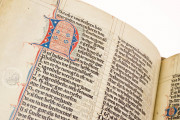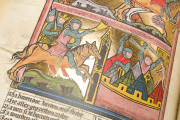For many centuries, the City of Saint Gall has preserved a most chivalrous magnificent manuscript of the Late Middle Ages. This codex exemplifies, in both script and language, in miniature painting and narrative verse, a highlight of Southern German Gothic. Its poetic literature and pictorial decoration record the world history for the ages, as it presented itself to the eyes and ears of a knightly round enjoying a glass of good wine.
It was around 1300 that the court commissioned two Middle High German poems to be written on vellum and embellished with vivid scenes on a gilded ground.
The first written version of these works dates back to half a century earlier. It is the World Chronicle by Rudolf von Ems and the Life of Charlemagne, recorded by an anonymous author called "Der Stricker."
The Old Testament as the Main Source for the World Chronicle
During his last years, Rudolf von Ems wrote a World Chronicle of over 33,000 verses in consecutive rhyme, commissioned by Conrad IV, one of the Staufer Kings. This chronicle deals with the world's history, from the Creation to the death of King Solomon, in the Middle High German language.
Towards the end of the Middle Ages, the World Chronicle obviously became one of the most popular poems, as it recounted biblical history in the contemporary language of the time. It recites the biblical history of salvation, as seen from the times past, but rearranged before the background of contemporary life.
In the same way, the precious miniatures aim to guide the reader to this very point, in the company of extremely lean women in flowing gowns or by brave knights in shining armor. The overall goal was to transpose the history of long past centuries into the experiences of the world of the High Gothic period.
The Saint Gall manuscript thus became, even outside the area of Lake Constance, the reference for later illustrated chronicles and a precious testimony to German book illumination of the Middle Ages.
Charlemagne, the Perfection of a Christian Ruler
The epic of the "Stricker" was extremely well known in the Middle Ages and goes back to the Chanson de Roland, a piece of Old French poetry, which the cleric Conrad of Regensburg first translated into German in 1170.
The "Stricker" enlarged the old heroic epic set in the environment of Charlemagne to a didactic anthology of the chivalrous lifestyle. The plot is based on the legend of Charlemagne and his faithful battle companion Roland who, with the support of his sword Durandal and his horn Olifant, fights on his side against the Saracens but is finally killed after having achieved real wonders of braveness.
In the end, the emperor, alerted by Roland's horn, arrives too late to save his companion's life but wins the battle against the Saracens. It later went down in history as the decisive battle between Christians and Heathens in Europe.
Chivalrous, Courtly Lifestyle Depicted in Precious Miniatures
The Saint Gall manuscript is the most important work of the transitory period in Southern German book illumination. In a fresh, corporal language and alemannic delight in narration, the fifty-eight miniatures on a gilded ground provide a perfect image of the lifestyle which prevailed at the noble courts of the late thirteenth century.
There is a new life-like and vivid expressiveness that for the first time breaks with the angular and twisted Northern German "Zackenstil," a sure sign of a new current introduced by French artists of the time.
Heroes from the Old Testament in tournament gear, court ladies in flowing dresses recount fascinating biblical events and heroic legends from Antiquity as well as from the environment of Charlemagne.
Rudolf von Ems and "Der Stricker"
Rudolf von Ems is thought to have originated from the village of Hohenems in the Austrian province of Vorarlberg, a village closely connected to Saint Gall abbey throughout the centuries. Born around 1200 into the knightly society, he was later promoted to court poet of the Staufer dynasty because of his good education.
Although tradition knows very little about Rudolf von Ems, even less information exists about his contemporary, the "Stricker." However, from his works we gather that he was neither a member of the clergy nor a knight, but originally rather came from the bourgeoisie.
In one of his writings he refers to himself as a "homeless" person. Obviously based in Southwest Germany, he wrote a number of verse epics, rhymed farces, and didactic poems.
We have 1 facsimile edition of the manuscript "Saint Gall World Chronicle": Rudolf von Ems Weltchronik. Der Stricker Karl der Große facsimile edition, published by Faksimile Verlag, 1982
Request Info / Price
